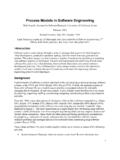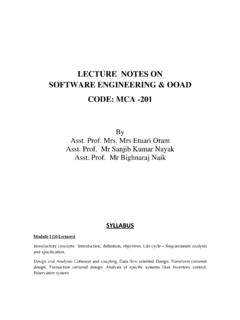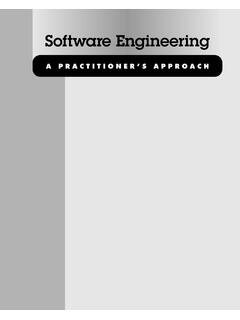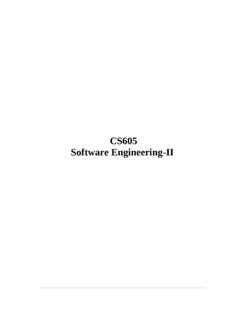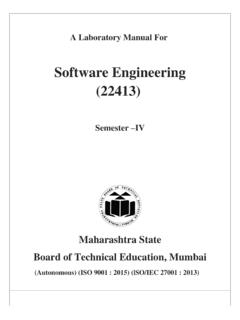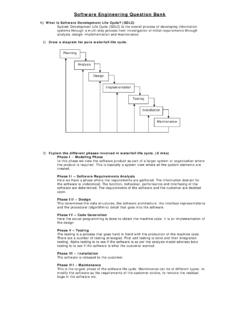Transcription of Software Engineering, 9th Edition - UOITC
1 Software ENGINEERINGN inth EditionIan SommervilleAddison-WesleyBoston Columbus Indianapolis New York San Francisco Upper Saddle RiverAmsterdam Cape Town Dubai London Madrid Milan Munich ParisMontreal TorontoDelhi Mexico City S o Paulo Sydney Hong Kong Seoul SingaporeTaipei TokyoEditorial Director: Marcia HortonEditor in Chief: Michael HirschAcquisitions Editor: Matt GoldsteinEditorial Assistant: Chelsea BellManaging Editor: Jeff HolcombSenior Production Project Manager: Marilyn LloydDirector of Marketing: Margaret WaplesMarketing Coordinator: Kathryn FerrantiSenior Manufacturing Buyer: Carol MelvilleText Designer: Susan RaymondCover Art Director: Elena SidorovaFront Cover Photograph: Jacques Pavlovsky/Sygma/CorbisInterior Chapter Opener: Project Management: Andrea Stefanowicz, GGS Higher Education Resources, a Division of PreMedia Global, and Illustrations: GGS Higher Education Resources, a Division of PreMedia Global, : Edwards BrothersCover Printer: Lehigh-Phoenix Color/HagerstownCopyright 2011, 2006, 2005, 2001, 1996 Pearson Education, Inc.
2 , publishing as Addison-Wesley. Allrights reserved. Manufactured in the United States of America. This publication is protected by copyright,and permission should be obtained from the publisher prior to any prohibited reproduction, storage in aretrieval system, or transmission in any form or by any means, electronic, mechanical, photocopying,recording, or likewise. To obtain permission(s) to use material from this work, please submit a writtenrequest to Pearson Education, Inc., Permissions Department, 501 Boylston Street, Suite 900, Boston,Massachusetts of the designations by manufacturers and seller to distinguish their products are claimed as trade-marks. Where those designations appear in this book, and the publisher was aware of a trademark claim,the designations have been printed in initial caps or all of Congress Cataloging-in-Publication DataSommerville, IanSoftware engineering / Ian Sommerville.
3 9th : 978-0-13-703515-1 ISBN-10: 0-13-703515-21. Software engineering . I. Title. dc22200905305810 9 8 7 6 5 4 3 2 1 EB 14 13 12 11 10 ISBN 10:0-13-703515-2 ISBN 13: 978-0-13-703515-1 PREFACEAs I was writing the final chapters in this book in the summer of 2009, I realizedthat Software engineering was 40 years old. The name Software engineering wasproposed in 1969 at a NATO conference to discuss Software development problems large Software systems were late, did not deliver the functionality needed by theirusers, cost more than expected, and were unreliable. I did not attend that conferencebut, a year later, I wrote my first program and started my professional life in in Software engineering has been remarkable over my professional life-time. Our societies could not function without large, professional Software building business systems, there is an alphabet soup of technologies J2EE.
4 NET, SaaS, SAP, BPEL4WS, SOAP, CBSE, etc. that support the development anddeployment of large enterprise applications. National utilities and infrastructure energy, communications, and transport all rely on complex and mostly reliablecomputer systems. Software has allowed us to explore space and to create the WorldWide Web, the most significant information system in the history of is now faced with a new set of challenges climate change and extremeweather, declining natural resources, an increasing world population to be fed andhoused, international terrorism, and the need to help elderly people lead satisfyingand fulfilled lives. We need new technologies to help us address these problems and,for sure, Software will play a central role in these engineering is, therefore, a critically important technology for the futureof mankind. We must continue to educate Software engineers and develop the disci-pline so that we can create more complex Software systems.
5 Of course, there are stillproblems with Software projects. Software is still sometimes late and costs morethan expected. However, we should not let these problems conceal the real successesin Software engineering and the impressive Software engineering methods and tech-nologies that have been engineering is now such a huge area that it is impossible to cover thewhole subject in one book. My focus, therefore, is on key topics that are fundamentalivPrefaceto all development processes and topics concerned with the development of reliable,distributed systems. There is an increased emphasis on agile methods and softwarereuse. I strongly believe that agile methods have their place but so too does tradi-tional plan-driven Software engineering . We need to combine the best of theseapproaches to build better Software inevitably reflect the opinions and prejudices of their authors. Some read-ers will inevitably disagree with my opinions and with my choice of material.
6 Suchdisagreement is a healthy reflection of the diversity of the discipline and is essentialfor its evolution. Nevertheless, I hope that all Software engineers and Software engi-neering students can find something of interest with the WebThere is an incredible amount of information on Software engineering available on theWeb and some people have questioned if textbooks like this one are still , the quality of available information is very patchy, information is sometimespresented badly and it can be hard to find the information that you need. Consequently,I believe that textbooks still have an important role to play in learning. They serve as aroadmap to the subject and allow information on method and techniques to be organizedand presented in a coherent and readable way. They also provide a starting point fordeeper exploration of the research literature and material available on the Web. I strongly believe that textbooks have a future but only if they are integrated withand add value to material on the Web.
7 This book has therefore been designed as ahybrid print/web text in which core information in the printed Edition is linked tosupplementary material on the Web. Almost all chapters include specially written web sections that add to the information in that chapter. There are also four webchapters on topics that I have not covered in the print version of the website that is associated with the book is: book s web has four principal sectionsThese are extra sections that add to the content presented in eachchapter. These web sections are linked from breakout boxes in each chaptersThere are four web chapters covering formal methods, interactiondesign, documentation, and application architectures. I may add other chapterson new topics during the lifetime of the for instructorsThe material in this section is intended to support peo-ple who are teaching Software engineering . See the Support Materials sectionin this studiesThese provide additional information about the case studies usedin the book (insulin pump, mental health-care system, wilderness weather system)Prefacevas well as information about further case studies, such as the failure of theAriane 5 well as these sections, there are also links to other sites with useful material onsoftware engineering , further reading, blogs, newsletters, welcome your constructive comments and suggestions about the book and thewebsite.
8 You can contact me at Please include[SE9] in the subject of your message. Otherwise, my spam filters will probablyreject your mail and you will not receive a reply. I do not have time to help studentswith their homework, so please don t book is primarily aimed at university and college students taking introductoryand advanced courses in Software and systems engineering . Software engineers inthe industry may find the book useful as general reading and as a means of updatingtheir knowledge on topics such as Software reuse, architectural design, dependabilityand security, and process improvement. I assume that readers have completed anintroductory programming course and are familiar with programming from previous editionsThis Edition has retained the fundamental material on Software engineering that wascovered in previous editions but I have revised and updated all chapters and haveincluded new material on many different topics.
9 The most important changes move from a print-only book to a hybrid print/web book with the web mate-rial tightly integrated with the sections in the book. This has allowed me to reducethe number of chapters in the book and to focus on core material in each restructuring to make it easier to use the book in teaching softwareengineering. The book now has four rather than eight parts and each part may beused on its own or in combination with other parts as the basis of a softwareengineering course. The four parts are an introduction to Software Engineering, dependability and security, advanced Software engineering , and Software engi-neering topics from previous editions are presented more concisely in a singlechapter, with extra material moved onto the web chapters, based on chapters from previous editions that I havenot included here, are available on the have updated and revised the content in all chapters.
10 I estimate that between30% and 40% of the text has been completely have added new chapters on agile Software development and embedded well as these new chapters, there is new material on model-driven engineer-ing, open source development, test-driven development, Reason s Swiss Cheesemodel, dependable systems architectures, static analysis and model checking,COTS reuse, Software as a service, and agile new case study on a patient record system for patients who are undergoingtreatment for mental health problems has been used in several the book for teachingI have designed the book so that it can be used in three different types of softwareengineering introductory courses in Software engineeringThe first part of the bookhas been designed explicitly to support a one-semester course in introductorysoftware or intermediate courses on specific Software engineering topicsYoucan create a range of more advanced courses using the chapters in Parts 2 4.




